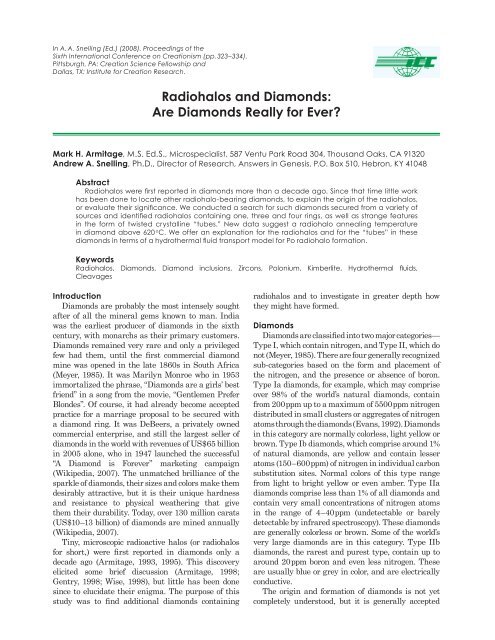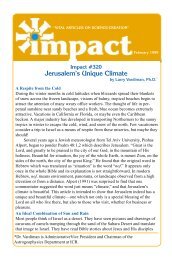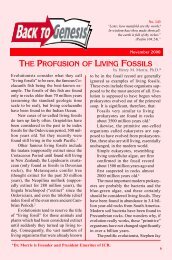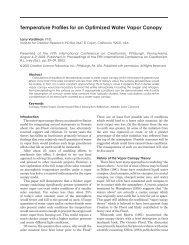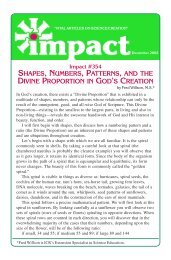Radiohalos and Diamonds - CiteSeer
Radiohalos and Diamonds - CiteSeer
Radiohalos and Diamonds - CiteSeer
Create successful ePaper yourself
Turn your PDF publications into a flip-book with our unique Google optimized e-Paper software.
In A. A. Snelling (Ed.) (2008). Proceedings of theSixth International Conference on Creationism (pp. 323–334).Pittsburgh, PA: Creation Science Fellowship <strong>and</strong>Dallas, TX: Institute for Creation Research.<strong>Radiohalos</strong> <strong>and</strong> <strong>Diamonds</strong>:Are <strong>Diamonds</strong> Really for Ever?Mark H. Armitage, M.S. Ed.S., Microspecialist, 587 Ventu Park Road 304, Thous<strong>and</strong> Oaks, CA 91320Andrew A. Snelling, Ph.D., Director of Research, Answers in Genesis, P.O. Box 510, Hebron, KY 41048Abstract<strong>Radiohalos</strong> were first reported in diamonds more than a decade ago. Since that time little workhas been done to locate other radiohalo-bearing diamonds, to explain the origin of the radiohalos,or evaluate their significance. We conducted a search for such diamonds secured from a variety ofsources <strong>and</strong> identified radiohalos containing one, three <strong>and</strong> four rings, as well as strange featuresin the form of twisted crystalline “tubes.” New data suggest a radiohalo annealing temperaturein diamond above 620 o C. We offer an explanation for the radiohalos <strong>and</strong> for the “tubes” in thesediamonds in terms of a hydrothermal fluid transport model for Po radiohalo formation.Keywords<strong>Radiohalos</strong>, <strong>Diamonds</strong>, Diamond inclusions, Zircons, Polonium, Kimberlite, Hydrothermal fluids,CleavagesIntroduction<strong>Diamonds</strong> are probably the most intensely soughtafter of all the mineral gems known to man. Indiawas the earliest producer of diamonds in the sixthcentury, with monarchs as their primary customers.<strong>Diamonds</strong> remained very rare <strong>and</strong> only a privilegedfew had them, until the first commercial diamondmine was opened in the late 1860s in South Africa(Meyer, 1985). It was Marilyn Monroe who in 1953immortalized the phrase, “<strong>Diamonds</strong> are a girls’ bestfriend” in a song from the movie, “Gentlemen PreferBlondes”. Of course, it had already become acceptedpractice for a marriage proposal to be secured witha diamond ring. It was DeBeers, a privately ownedcommercial enterprise, <strong>and</strong> still the largest seller ofdiamonds in the world with revenues of US$65 billionin 2005 alone, who in 1947 launched the successful“A Diamond is Forever” marketing campaign(Wikipedia, 2007). The unmatched brilliance of thesparkle of diamonds, their sizes <strong>and</strong> colors make themdesirably attractive, but it is their unique hardness<strong>and</strong> resistance to physical weathering that givethem their durability. Today, over 130 million carats(US$10–13 billion) of diamonds are mined annually(Wikipedia, 2007).Tiny, microscopic radioactive halos (or radiohalosfor short,) were first reported in diamonds only adecade ago (Armitage, 1993, 1995). This discoveryelicited some brief discussion (Armitage, 1998;Gentry, 1998; Wise, 1998), but little has been donesince to elucidate their enigma. The purpose of thisstudy was to find additional diamonds containingradiohalos <strong>and</strong> to investigate in greater depth howthey might have formed.<strong>Diamonds</strong><strong>Diamonds</strong> are classified into two major categories—Type I, which contain nitrogen, <strong>and</strong> Type II, which donot (Meyer, 1985). There are four generally recognizedsub-categories based on the form <strong>and</strong> placement ofthe nitrogen, <strong>and</strong> the presence or absence of boron.Type Ia diamonds, for example, which may compriseover 98% of the world’s natural diamonds, containfrom 200 ppm up to a maximum of 5500 ppm nitrogendistributed in small clusters or aggregates of nitrogenatoms through the diamonds (Evans, 1992). <strong>Diamonds</strong>in this category are normally colorless, light yellow orbrown. Type Ib diamonds, which comprise around 1%of natural diamonds, are yellow <strong>and</strong> contain lesseratoms (150–600 ppm) of nitrogen in individual carbonsubstitution sites. Normal colors of this type rangefrom light to bright yellow or even amber. Type IIadiamonds comprise less than 1% of all diamonds <strong>and</strong>contain very small concentrations of nitrogen atomsin the range of 4–40 ppm (undetectable or barelydetectable by infrared spectroscopy). These diamondsare generally colorless or brown. Some of the world’svery large diamonds are in this category. Type IIbdiamonds, the rarest <strong>and</strong> purest type, contain up toaround 20 ppm boron <strong>and</strong> even less nitrogen. Theseare usually blue or grey in color, <strong>and</strong> are electricallyconductive.The origin <strong>and</strong> formation of diamonds is not yetcompletely understood, but it is generally accepted
324that diamonds crystallized from a liquid melt in theearth’s upper mantle at depths of between 150 <strong>and</strong>300 km (Kirkley, Gurney, & Levinson, 1991). At thesedepths the temperatures range from 1100–2900° C<strong>and</strong> the pressures range from 50–100 kilobars, ascalculated <strong>and</strong> confirmed by laboratory studies ofthe minerals in rock fragments brought up from theearth’s upper mantle with the diamonds in volcanicrocks (Mitchell, 1991). Some diamonds may even haveformed at depths of 450 km below the earth’s surface,because of the great temperatures <strong>and</strong> pressuresrequired for certain mineral inclusions in them toform (Meyer, 1987).Most natural diamonds so far discovered arethought to have crystallized between 1 <strong>and</strong> 3 billionyears ago in mantle rock containing relatively highconcentrations of magnesium <strong>and</strong> iron (Meyer, 1985;Stachel, Banas, Muehlenbachs, Kurszlaukis, &Walker, 2006). The processes of diamond formation areinferred on the basis of what is known of conditions inthe earth’s upper mantle at 150–300 km depth (Rice,2003; Shirey, Richardson, & Harris, 2004; Tappert,Stachel, Harris, Muehlenbachs, Ludwig, & Brey,2005). The origin of the carbon source for diamondsis also still very much debated (Banas, Stachel,Muehlenbachs, & McC<strong>and</strong>less, 2007; Gunn & Luth,2006; Rice, 2003). Once formed, the diamonds seemedto have resided for hundreds of millions up to 2 billionyears in the upper mantle beneath the Archeankeels of the continental Precambrian cratons. Thediamond phase of carbon, once crystallized, remainsstable there, because of the high temperatures <strong>and</strong>pressures.It is generally postulated that localized meltingof the mantle subsequently occurred to produce amagma rich in CO 2<strong>and</strong> H 2O, either a kimberlite orlamproite. This volatile-rich magma then began risingexplosively through the mantle areas containing thediamonds <strong>and</strong> transported the diamonds through thecrust to the earth’s surface at speeds of 10–30 kmper hour via propagating cracks in the mantle <strong>and</strong>the crust above (Kelley & Wartho, 2000; Snelling,1994). The kimberlite <strong>and</strong> lamproite magmas cooledas they approached the earth’s surface <strong>and</strong> thereforehardened, so the resultant explosive eruptions oftenshattered the solidified magmas in what were coldvolcanic eruptions. What remained in the conduit <strong>and</strong>the material that settled back into it after the eruptionscontains the diamonds in pipe-like structures. If thesekimberlite <strong>and</strong> lamproite magmas did not ascendcatastrophically from the upper mantle to the earth’ssurface within 8–24 hours, the diamond crystalswould have become unstable at the changing pressure<strong>and</strong> temperature conditions during their passage<strong>and</strong> would have reverted to graphite. At the earth’ssurface these kimberlite <strong>and</strong> lamproite pipes weatherM. H. Armitage & A. A. Snelling<strong>and</strong> are eroded so the diamonds are shed into alluvialdeposits in river systems, deltas <strong>and</strong> along coastlines.The diamonds that remain in the pipes may be mined,often from great depths. For some diamond depositsno formation process has been proposed (Banas et al,2007; DeStefano, Lefebvre, & Kopylova, 2006; Leost,Stachel, Brey, Harris, & Ryabchikov, 2003; Stachel,Viljoen, McDade, & Harris, 2004).Efforts to produce gem-grade synthetic diamonds,though intensive, have produced only meager results.In 1955 researchers at General Electric successfullysynthesized tiny industrial-grade diamonds overseveral weeks of extreme laboratory temperatures<strong>and</strong> pressures over intervals of several weeks(Koskoff, 1981). Since then many small industrialgradediamonds have been produced (some estimatesare as high as 100,000 carats per year). In order toproduce these diamonds, carbon must be subjected tovery high pressures <strong>and</strong> temperatures in the presenceof transition metals (or some other “seed”) to get thereaction started (Gunn & Luth, 2006; Langenhorst,Poirier, & Frost, 2004; Zhou, Jia, Chen, Guo, & Li,2006). Although gem quality diamonds as large as5 carats have been produced, the cost of productiongenerally remains prohibitively high. DeBeers claimsthat their equipment can detect the difference betweensynthetic <strong>and</strong> natural diamonds; but that claim ishighly disputed. Synthetic gemstones larger than 1carat are not readily produced or available.<strong>Diamonds</strong> are mentioned in several places in theScriptures. A diamond was among the 12 gemstoneson the high priest’s breastplate representing the 12tribes of Israel before God (Exodus 20:18; 39:11).<strong>Diamonds</strong> were thus looked upon by God as things ofbeauty, purity <strong>and</strong> value. Indeed, in reference to the“anointed cherub” in Ezekiel 28:13–14, his coveringin “the garden of God” <strong>and</strong> “upon the holy mountainof God” was “every precious stone” including thediamond. This implies that diamonds, along withother gemstones, were present in <strong>and</strong> on the earthafter God created it, so if diamonds are really as “old”as claimed, then they may date back to the originalcreation. Their presence in the earth’s crust today<strong>and</strong> at the earth’s surface may then largely be due tothe subsequently eruption of kimberlite <strong>and</strong> lamproitemagmas during the Flood. <strong>Diamonds</strong> <strong>and</strong> their originhave occasionally featured in creationist news reports<strong>and</strong> literature (Baumgardner, 2005; Brown, 1997;Chaffin, 1986; DeYoung, 1982; Oard, 2004; Sarfati,2006; Snelling, 1994, 1996).Inclusions in <strong>Diamonds</strong>Natural diamonds (<strong>and</strong> many other crystallinematerials) often encase smaller grains or crystalsof other minerals within their crystalline matrices,<strong>and</strong> these are known as inclusions. Twenty to thirty
<strong>Radiohalos</strong> <strong>and</strong> <strong>Diamonds</strong>: Are <strong>Diamonds</strong> Really for Ever?different minerals have been described as inclusionsinside natural diamonds, along with 58 different typesof impurities, including uranium <strong>and</strong> thorium (Meyer,1987). Synthetic diamonds also suffer from inclusions,but these are mostly metal fragments introducedin the manufacturing process (Langenhorst et al,2004). In the case of the natural diamonds, theseincluded minerals must have been present at thetime the diamonds formed to be incorporated withinthe diamond matrix. As far as has been ascertained,diamonds are almost completely chemically inert <strong>and</strong>extremely resistant to any contamination or chemicalexchange within their crystal lattice. This means theywould have traveled from the earth’s upper mantle<strong>and</strong> through the crust to the earth’s surface carryingthese inclusions completely intact <strong>and</strong> unchangedduring the 150–300 km ascent (Baumgardner, 2005;Dobrzhinetskaya, Green, Bozhilov, Mitchell, &Dickerson, 2003; Meyer, 1985; Promprated, Taylor,An<strong>and</strong>, Floss, Sobolev, & Pokhilenko, 2004; Tappertet al., 2005). Therefore, these inclusions represent tiny“capsules” of mantle materials captured under mantleconditions that have been safely delivered from theupper mantle to the earth’s surface. Yet there are someas yet unexplained mysteries concerning the typesof inclusions found in diamonds. For example, it iswell known that sulfides represent the most commoninclusions in diamonds, implying that these sulfidesformed in the mantle. Yet many mantle xenolithsbrought from the upper mantle to the earth’s surfaceby volcanic eruption contain only small quantities ofsulfides (Westerlund, Guknhy, Caklson, Shirey, Hauri,& Richardson, 2004). Furthermore, it is puzzling asto how saline liquids <strong>and</strong> water, plus gases, are oftenencapsulated as fluid inclusions within diamonds atsuch depths (<strong>and</strong> pressures).Inclusions consist of, but are not limited to, apatite,calcite, carbonates, chromite, smaller diamonds,garnet, hematite, iron, mica, pyrite, pyroxene,silicates, sulfides, zircon, <strong>and</strong>, as mentioned, liquids(such as liquid CO 2, water <strong>and</strong> even brine) <strong>and</strong> gases(Anonymous, 2001, 2003; Bizzarro & Stevenson,2003; Jacob, Kronz, & Viljoen, 2004; Klein-BenDavid,Izraeli, Hauri, & Navon, 2007; Navon, Izraeli, & Klein-BenDavid, 2003; Promprated et al., 2004; Stachel etal., 2004, Tappert et al., 2005; Tomlinson, Jones, &Harris, 2006; Westlund & Gurney, 2004).Frequently mineral inclusions contain radioactivenuclides such as uranium or thorium incorporatedwithin the crystalline lattice of the inclusion. Theseradioactive nuclides eject alpha particles as a normalpart of the radioactive decay process. Alpha-particlestravel some distance in the mineral (<strong>and</strong> then intothe surrounding host) depending on the energy atwhich they were ejected from the nucleus of thenuclide as well as the characteristics of the crystalline325material(s). The crystalline lattice structure ofinclusions, including zircons, may tend to becomesomewhat amorphous over time if sufficient selfirradiationtakes place (Nasdala, Wenzel, Andrut,Wirth, & Blaum, 2001; Nasdala, Wildner, Wirth,Groschopf, Pal, & Moller, 2006).The presence of zircons in diamonds is consideredrare, but they have been previously reported (Kinney& Meyer, 1993, 1994). It may be that few reports ofzircon inclusions have appeared because zircons arenot expected to be at depths in the mantle wherediamonds are thought to form (Meyer, 1985). Theconsensus is that zircons exist predominately in theearth’s crust. Because of their extreme hardness, itis unlikely that diamonds can incorporate zirconsfrom the crust during their ascent from the mantleto the earth’s surface (J. Baumgardner, personalcommunication, April 2, 2007). Nevertheless, zirconinclusions occur within diamonds <strong>and</strong> have beenreported (Kinney & Meyer, 1993, 1994). Furthermore,there have even been reports of diamond inclusionswithin zircons (Dobrzhinetskaya et al., 2003; Kinney<strong>and</strong> Meyer, 1994; Menneken, Nemchin, Geisler,Pidgeon & Wilde, 2007), but these are microdiamondsformed under ultrametamorphic conditions in theearth’s crust (Dobrzhinetskaya et al., 1995; Snelling,1996).Zircons are known to contain radioactive nuclides(such as described above) <strong>and</strong> they are also well knownin their role as radiocenters for 238 U radiohalos, whichhave been observed in biotite, chlorite, cordierite,fluorite, sapphire, quartz <strong>and</strong> other minerals(Coenraads, Sutherl<strong>and</strong>, & Kinney, 1990; Gentry,1973; Ion, Ion-Mihai, Ion, & S<strong>and</strong>ru, 2003; Nasdalaet al., 2001, 2006; Pal, 2004; Snelling, 2000, 2005a).One well-known researcher commented, however, thathe was not aware of any report describing uraniumin diamond (K. N. Bozhilov, personal communication,June 16, 2006). Nevertheless, zircon inclusions insapphires are known to contain uranium, the parentradionuclide for polonium (Coenraads, Sutherl<strong>and</strong>,& Kinney, 1990) <strong>and</strong> others have described suchradioactive elements in other rocks from diamondbearingkimberlites (Kramers, 1979).<strong>Radiohalos</strong> are minute circular areas (in crosssection)of discoloration <strong>and</strong> darkening caused bydamage from α-particle radiation emanating from atiny central inclusion containing radioactive elementssuch as U <strong>and</strong> Th (Gentry, 1973; Snelling, 2000). Thedamage is mostly from point vacancies produced in thecrystal lattice of the host mineral by the α-particles.The identity of the isotopic species responsible for agiven ring in the darkened region can be determinedfrom the ring’s diameter, which is proportional tothe energy of the alpha particles emitted by theisotopic species. The rare element polonium (Po) is
326momentarily produced as three isotopes in the 238 Udecay chain— 218 Po, 214 Po <strong>and</strong> 210 Po. Whereas a 238 Uradiohalo consists of eight rings, radiohalos are alsofound with only three, two <strong>and</strong> one rings, resultingfrom, respectively, the α-decay of these three Poisotopes. Such 218 Po, 214 Po, <strong>and</strong> 210 Po radiohalos hadto have been produced with the respective Po isotopesexclusively present in their radiocenters. It has beenestimated that each radiohalo requires between 500million <strong>and</strong> 1 billion α-particles to form it (Gentry,1988).Doubts have been raised concerning whetherradiohalos interpreted as polonium radiohalos havebeen correctly identified. For example, Moazed,Spector, <strong>and</strong> Ward (1973) <strong>and</strong> Moazed, Overbey,<strong>and</strong> Spector (1975) claim that single, double, triple<strong>and</strong> quadruple ring radiohalos can clearly <strong>and</strong>unambiguously be shown to have been generatedby the 238 U <strong>and</strong> 232 Th decay chains, rather thanby “parentless” polonium isotopes as proposed byGentry (1974, 1984, 1986, 1988). This claim is basedpartly on the issue of potential uncertainties in theion microprobe analyses of the halo radiocenters.However, Gentry (1974, 1986) <strong>and</strong> Gentry, Hulett,Cristy, McLaughlin, McHugh, <strong>and</strong> Bayard (1974)have refuted this claim, demonstrating that due carewas taken in these analyses, <strong>and</strong> other techniqueswere employed for comparison to rule out suchuncertainties. Furthermore, most of the many othersthat disagree with Gentry’s model for the formationof these polonium radiohalos have accepted theircorrect identification (for example, Damon, 1979;Dutch, 1983; Wakefield, 1988; Wilkerson, 1989;York, 1979). Indeed, Collins (1992) goes further<strong>and</strong> specifically includes the Moazed, Overbey, <strong>and</strong>Spector (1975) claim in his list of attempts to explainGentry’s conundrum that are not fully satisfactory. Inany case, Meier <strong>and</strong> Hecker (1976) have conclusivelyshown that polonium radiohalos are sometimesassociated with polonium b<strong>and</strong>s generated by thepolonium being transported by hydrothermal fluidsalong fractures. Thus the overwhelming consensusis that the polonium radiohalos have been correctlyidentified.The formation of Po radiohalos has thus beensomewhat enigmatic, given the short half-lives of thethree Po isotopes—3.1 minutes, 164 microseconds<strong>and</strong> 138 days, respectively. Conventionally the Poradiohalos have been called “a very tiny mystery”without further explanation (Dalrymple, as quotedby Gentry, 1988, p. 122). The mystery in question ishow these polonium isotopes could have been derived<strong>and</strong> separated from a nearby source of 238 U to thenbe concentrated in radiocenters to produce the Poradiohalos, all within ten half-lives of these Po isotopes,corresponding to their effective life-spans (1.64M. H. Armitage & A. A. Snellingmilliseconds in the case of 214 Po). Therefore, Gentry(1974, 1984, 1986, 1988) proposed that the poloniumhad to have been primordial, created in place in theradiocenters <strong>and</strong> then nearly instantaneously producethe Po radiohalos. Furthermore, he maintained, if thePo was primordial, then the host crystals <strong>and</strong> rocks(for example, biotite flakes <strong>and</strong> their host granites)also had to have been created at the same time.However, as pointed out by Wise (1989) <strong>and</strong> Snelling(2000), many granites that contain Po radiohalosappear from their geologic contexts to have beenformed during the Flood, <strong>and</strong> therefore cannot havebeen primordial (that is, created) granites. Thisin turn implies that the Po which generated the Poradiohalos in those granites could not have beenprimordial Po. Indeed, Snelling <strong>and</strong> Armitage (2003)studied three specific Po-radiohalo-bearing graniteplutons that they demonstrated had to have beengenerated <strong>and</strong> formed during the Flood. Therefore,Snelling <strong>and</strong> Armitage (2003) <strong>and</strong> Snelling (2005a)proposed a hydrothermal fluid transport model forPo radiohalo formation, which has been tested <strong>and</strong>verified by subsequent studies (Snelling, 2005b, 2006,2008; Snelling & Gates, 2008).Mendelssohn, Milledge, Vance, Nave, <strong>and</strong> Woods(1979) reported finding radiohalos on the outer surfacesof opaque diamonds using cathodoluminescence.Armitage (1993, 1995), however, was the first to reportoptically-visible, multi-ringed internal radiohalos ina Type Ia diamond. Despite the fact that exact sizematching with the radiohalos observed in biotiteswas difficult because of the greater density of thediamond’s carbon structure reduces the penetrationdistance of the α-particles, these radiohalo rings werenevertheless identified as produced by 218 Po, 214 Po,210Po, <strong>and</strong> 222 Ra. Furthermore, these radiohalos werefound along rod-like structures <strong>and</strong> at the terminiof strange hollow tubes that were bent repeatedlyat right angles within the diamond. Wise (1998)suggested that these structures represented fluidconduits along which the radioisotopes responsible forparenting these radiohalos had been transported intothe diamond, but both Armitage (1998) <strong>and</strong> Gentry(1998) maintained that this interpretation was notviable due to the diamond’s unfractured internalcrystal structure. They insisted instead that the shorthalf-lives of the radioisotopes responsible for the ringsin the radiohalos suggested a primordial origin for theradioisotopes <strong>and</strong> thus the diamond. Nevertheless,Vicenzi, Heaney, Snyder, <strong>and</strong> Armstrong (2002)reported radiation halos 25 micrometers in diameterin alluvially deposited polycrystalline diamonds(carbonados) from the Central African Republic, whichthey maintained were generated as a result of uraniumdeposition from a single pulse of fluids infiltrating thediamonds following their formation. Furthermore,
<strong>Radiohalos</strong> <strong>and</strong> <strong>Diamonds</strong>: Are <strong>Diamonds</strong> Really for Ever?whereas J. W. Harris (personal communication,May, 2007) has claimed, “over decades of looking atmillions of diamonds I have only once seen a green setof haloes inside a stone,” jewelers <strong>and</strong> gemologists insouthern California testify to having regularly seenradiohalo inclusions in diamonds <strong>and</strong> other gemstones(Armitage, personal communications with jewelers insouthern California, April, 2007; May, 2007).<strong>Diamonds</strong> ExaminedSixty-nine small diamonds <strong>and</strong> diamond chips fromdiamond mines in Kimberley (South Africa), Jwaneng(Namibia), <strong>and</strong> Orapa (Botswana), <strong>and</strong> from alluvialdiamond deposits in Namibia <strong>and</strong> Guinea, wereexamined for radiohalos. These diamonds were in thepossession of Dr. John Baumgardner at the Institutefor Creation Research in Santee, California. The twodiamonds with radiohalos in them examined in thisstudy were on loan from the Gemological Instituteof America laboratory (GIA), Carlsbad, California,courtesy of Dr. John Koivula <strong>and</strong> Thor Strom. Thefirst of these diamonds was a 0.06 carat, faceted stonefrom an unknown source. The other was described asa 0.11 carat diamond macle (or oddly shaped crystal)from the Diamantina mines, Gerias, Brazil.The diamonds of interest were photographed withfilm on a Zeiss Jena dissecting light microscopeconfigured with multiple fiber optic illuminators <strong>and</strong>an Olympus SLR film camera body. Illumination ofradiohalos proved difficult particularly since bothspecimens had been carbon-coated for examinationwith scanning electron microscopy (SEM), butSEM was not performed in this study. Prints of thenegatives made were digitally scanned.Twenty different jewelry stores in three countiesin southern California were visited over a period ofseveral weeks. Jewelers <strong>and</strong> gemologists at thosestores were interviewed. Half of the proprietorsstated that they had seen such radiohalo inclusionsin diamonds <strong>and</strong> other gemstones previously butFigure 1. Small inclusions in diamond from Orapa mine,Africa. Magnification 250×. Scale bar = 300 microns.327none of the twenty had any gemstones available forexamination.ResultsNo radiohalos were found in any of the Afric<strong>and</strong>iamonds. However, large numbers of variousinclusions (including possible zircons) were foundin them <strong>and</strong> some in the Orapa diamond werephotographed (Figure 1).<strong>Radiohalos</strong> with one, three, <strong>and</strong> four rings werefound in the GIA diamonds. The round brilliant cut0.06 carat diamond from an unknown source containeddozens of radiohalos <strong>and</strong> “etch trails” (Figures 2–4).Documentation was provided with this diamond. Itdescribed “etch trails” which intersected with theradiocenters of each halo sharply bent at differingangles (see Figure 4). These “etch trails” did notextend to the surface. Therefore, the diamond girdlewas ground away by GIA personnel until contactwith the etch trails was made (see ground girdle onFigures 4–5). The text stated that inclusions weresolid (crystalline?) <strong>and</strong> that “they appear to have ahexagonal outline.” These radiohalos (both 3 <strong>and</strong>4 ring varieties) were measured with a calibratedocular micrometer to 50 micrometers diameter.The diamond macle (oddly shaped crystal) fromBrazil (Figures 7–8) contained dozens of radiohalos,but only of the single ring variety. This documentationsupplied with this specimen stated “this 0.11 caratdiamond macle is from Diamantina mines, Gerais,Brazil. Its radiation spots with central ‘cores’ arefrom some unknown substance. These spots startedout green <strong>and</strong> changed to brownish orange when thediamond was heated to 620 °C. The first change in spotcolor was noticed at 590–600 °C.” These radiohalos(single ring only) were measured with a calibratedocular micrometer to 30 micrometers diameter.DiscussionThe crucial factor in the occurrence of the radiohaloswithin these two diamonds is the temperature atwhich radiohalos are annealed. At the annealingtemperature the vibrations of the atoms in the crystalstructure have increased sufficiently to repair thepoint vacancies caused by the previous α-particlebombardment, such that the darkening, <strong>and</strong> thusthe radiohalos, are erased. In biotites, radiohalosare erased above 150 °C (Laney & Laughlin, 1981).This annealing temperature was determined usingsamples taken from a drill-hole in which present insitu temperatures had been measured, <strong>and</strong> so could beinterpreted as having been determined under naturalconditions. In contrast, Armitage <strong>and</strong> Back (1994)placed biotite flakes containing radiohalos in an oven,heating them at temperatures up to 700 °C for up tofive hours. They found erasure of radiohalos occurred
328M. H. Armitage & A. A. SnellingFigure 2. Round, brilliant cut diamond. Note radiohalosat 12 o’clock position. Scale bar = 0.3 mmFigure 3. <strong>Radiohalos</strong> in round diamond. Magnification80×. Scale bar = 450 micrometers.Figure 4. <strong>Radiohalos</strong> in round diamond. Note right <strong>and</strong>sharp angles made by crystalline tubes. Magnification80×. Scale bar = 450 micrometers.Figure 5. <strong>Radiohalos</strong> in round diamond. Magnification100×. Scale bar = 160 micrometers.Figure 6. <strong>Radiohalos</strong> in round diamond. Magnification200×. Scale bar = 75 micrometers.after only an hour of heating at temperatures of250–550 °C. However, it is not known whetherradiohalos in diamonds are annealed at 150–250 °C.The Brazilian macle diamond was reported to havebeen heated to 620 °C without complete loss ofradiohalos. This would seem to imply that theannealing temperature of radiohalos in diamonds isFigure 7. <strong>Radiohalos</strong> in macle diamond from Brazil.Magnification 200×. Scale bar = 1 mm.higher than 620 °C.The temperatures at the 150–300 km depthsin the upper mantle where diamonds are inferredto have formed are 1100–2900 °C. Of course, anyradiohalos would only be generated in diamonds afterthe diamonds formed at those temperatures. If theannealing temperature of radiohalos in diamonds is
<strong>Radiohalos</strong> <strong>and</strong> <strong>Diamonds</strong>: Are <strong>Diamonds</strong> Really for Ever?Figure 8. <strong>Radiohalos</strong> in macle diamond. Magnification90×. Scale bar = 0.5 mm.higher than 620 °C, there is a greater temperaturewindow (compared with the 150 °C annealingtemperature of radiohalos in biotites) in whichmagmatic <strong>and</strong> hydrothermal fluids could transport238U <strong>and</strong> its decay products into <strong>and</strong> within diamonds.This assumes that 238 U, its decay products, or tinycrystals of a mineral such as zircon hosting them,had not been included in diamonds when they formed.Zircon inclusions in diamonds are considered to berare, but at the upper mantle temperatures at whichdiamonds have supposedly resided for hundredsof millions of years, before transport to the earth’ssurface by kimberlite <strong>and</strong> lamproite magmas, it ishighly unlikely radiohalos would have formed aroundany zircon inclusions.Instead, it is far more likely that 238 U <strong>and</strong> its decayproducts infiltrated the diamonds during <strong>and</strong> aftertheir ascent to the earth’s upper crust. However, whilekimberlite <strong>and</strong> lamproite magmas are volatile-rich,particularly with respect to CO 2, they contain verylittle water <strong>and</strong> so produce dry volcanic eruptions.Thus, as water is the likely transporter of 238 U <strong>and</strong> itsdecay products, the infiltration of water transporting238U <strong>and</strong> its decay products to form the radiohalos indiamonds would need to occur after the emplacementof the host kimberlite or lamproite at <strong>and</strong> near theearth’s surface. Indeed, even though the kimberlite<strong>and</strong> lamproite magmas are considered dry, they arenonetheless very hot (>1,000 °C) when emplaced,<strong>and</strong> their interaction with the ground waters in theimmediately surrounding intruded strata wouldgenerate in situ hydrothermal fluids (Snelling &Woodmorappe, 1998). That such fluids are generatedis confirmed by the ubiquitous hydrothermallyproduced minerals such as serpentine in kimberlites<strong>and</strong> lamproites. Such fluids would scavenge, dissolve,<strong>and</strong> concentrate 238 U <strong>and</strong> its decay products from boththe intruded strata <strong>and</strong> the congealed, rapidly cooled,<strong>and</strong> explosively fragmented intruding magmas.The next question has to be whether magmatic <strong>and</strong>329hydrothermal fluids can infiltrate into diamonds. BothArmitage (1998) <strong>and</strong> Gentry (1998) insisted that fluidinfiltration was not possible due to the unfractured,tight internal crystal structure of diamonds. However,Vicenzi et al (2002) maintained the radiohalosthey found in alluvially deposited carbonados weregenerated as a result of uranium deposition froma single pulse of fluids having infiltrated thosemicrocrystalline diamonds after their formation. Thecrystal structure of diamonds is cubic, <strong>and</strong> even thoughdiamonds fracture conchoidally, they exhibit cleavagein four directions (octahedral) with one perfect cubiccleavage {111} (Mason & Berry, 1968). As in the caseof the radiohalos in the diamond documented byArmitage (1994), many of the radiohalos in one ofthe diamonds in our study are centered along thindarkened straight lines within the diamond. Theselines appear to follow the directions of the cleavages(Figures 3–5). Other radiohalos are at the termini ofstrange darkened tubes that turn <strong>and</strong> twist at rightangles (Figure 4). Wise (1998) interpreted all thesefeatures as conduits along which fluids must havetransported the 238 U <strong>and</strong> its decay products responsiblefor the radiohalos. This interpretation is supported bythe observations made by Armitage <strong>and</strong> Back (1994)<strong>and</strong> in our study that the darkening along theselinear features <strong>and</strong> twisted tubes is due to radiationstaining. Furthermore, these linear features <strong>and</strong> thelinear sections of the twisted tubes appear to followthe perfect cleavages within the diamonds. Thesecleavages are the natural weaknesses of the diamondcrystal lattice along which infiltrating fluids might beexpected to flow.This interpretation raises several issues. Again, theintact crystal structure of diamonds, without clearlydeveloped fracture surfaces along cleavages, wouldseem not to be capable of providing open avenues forfluid infiltration. However, this concern is based onobservations of diamonds at ambient temperatures.By contrast, at the temperatures of 300–400 °C atwhich magmatic <strong>and</strong> hydrothermal fluids might haveinfiltrated, the heat would likely have exp<strong>and</strong>ed thediamond crystal structure, thus opening cleavageplanes to provide the necessary pathways for thesefluids. Yet how are these darkened linear features<strong>and</strong> “tubes” produced by fluid infiltration whencleavage planes are two-dimensional surfaces? Giventhat the diamond crystal structure is normally tight(close-packed), if the cleavages within it are openedby heat <strong>and</strong> fluid pressures, the easiest, most open,pathways for fluids to infiltrate would be at the linearintersections of cleavage planes. It then follows thatbecause there are essentially five cleavage planes indiamonds, the lines of intersection between them runin numerous directions, which would account for thetwisted tubes.
330It would also be precisely because of the tightcrystal structure of diamonds that some of thesetubes are twisted at right angles. Because all thecleavages are at varying angles only a few right angleswould seem possible, but the cubic cleavage plane isregarded as perfect (Mason & Berry, 1968). Armitage(1998) described these strange twisted tubes as solidinclusions, rather than being hollow as previouslythought (Armitage, 1994). A few of these twisted tubeswere found to extend to the surface of the diamond(Armitage, 1994), <strong>and</strong> not all of them terminated at aradiohalo. Furthermore, in both the Armitage (1994)diamond <strong>and</strong> the cut diamond in our study, both thedarkened linear tubes with radiohalos centered alongthem, <strong>and</strong> the twisted tubes terminating in radiohalos,usually do not reach the surfaces of these facetedstones. This would seem to argue against these tubeshaving been formed by fluid infiltration. However,the character of these tubes, <strong>and</strong> their containmentof solid mineral inclusions, suggest their formation asmineral inclusions via precipitation from infiltratingfluids. These would have to have been trapped in thediamond crystal structure long enough for the mineralmatter dissolved in them to precipitate.It is thus envisaged that with the emplacementof the host kimberlite pipe, connate water in thesurrounding intruded strata was heated by thecooling kimberlite, <strong>and</strong> the hydrothermal fluidsthus generated infiltrated the still warm diamondswithin the kimberlite, carrying 238 U <strong>and</strong> its decayproducts scavenged from the intruded strata. Heateddiamonds exp<strong>and</strong>ed sufficiently to facilitate fluidinfiltration along cleavage planes; but because of thetight diamond crystal structure, where the fluidsmet resistance within the diamonds because thecleavages would not open further, the fluids insteadexploited any weakness along the intersectionsbetween other cleavage directions. Thus some of thelinear fluid pathways became twisted repeatedly atright angles as the fluids infiltrated where cleavageintersections were sufficiently open to them. As thediamonds first cooled at their outer surfaces, thecleavages infiltrated by the fluids would contract <strong>and</strong>close first at their outer surfaces, locking the fluidsinto those cleavages where the contained elements<strong>and</strong> minerals then precipitated. Because 238 U <strong>and</strong> itsdecay products were dissolved in these infiltratingfluids, α-radiation tracks would be left along thecleavage pathways traversed by the fluids. The 238 Udecay products in the fluids apparently becameconcentrated in nucleation or precipitation centers,where trace atoms such as Cl (present in diamonds)chemically attracted Po. These precipitated Po atomsthen “parented” the now observed radiohalos. Thehalf-lives of these radioisotopes are short ( 210 Po 138days, 218 Po 3.1 minutes, <strong>and</strong> 214 Po 164 microseconds);M. H. Armitage & A. A. Snellingbut isolated 214 Po radiohalos may be accounted forby retention in the infiltrating fluid of the 27-minutehalf-life parent 214 Pb <strong>and</strong> the 20-minute half-lifeparent 214 Bi. Similarly, isolated 210 Po radiohalos maybe accounted for by retention of the 22-year half-lifeparent 210 Pb <strong>and</strong> the 5-day half-life parent 210 Bi. Asatisfactory explanation for the observed densityratios of polonium radiohalos awaits further study.The single ring radiohalos in the Brazilianmacle diamond, most probably 210 Po radiohalos, aredispersed r<strong>and</strong>omly <strong>and</strong> sometimes apparently inclusters, <strong>and</strong> do not seem to be along any radiationstainedlinear features (Figures 7–8). This doesnot mean the 210 Po was not transported into thisdiamond by fluid infiltration along cleavages. Rather,it suggests that the 210 Po transport was so rapidthere was insufficient time for radiation stainingto develop along the cleavages infiltrated by thefluids. Furthermore, the oddly shaped nature of thismacle diamond has two other implications. First, itscontraction accompanying cooling after emplacementwould have been very rapid due to its likely less orderlycrystalline structure; <strong>and</strong> thus fluid infiltration toproduce these 210 Po radiohalos also needed to be veryrapid. And second, the packing of its crystal structurewould mean that its cleavages are not as well defined,<strong>and</strong> the infiltrating fluids would have more readilydispersed around the constituent components ofits crystal lattice rather than along cleavages. Thisis consistent with its distribution pattern of 210 Poradiohalos. However, since only 210 Po radiohalos arepresent in this macle diamond, the infiltrating fluidslikely only transported 210 Po scavenged from the hostkimberlite <strong>and</strong> the intruded strata. The fluids whichinfiltrated the other diamond we studied had to havecarried radioisotopes higher up the 238 U decay chain,at least up to 1,000 year half-life 226 Ra, which isreadily soluble in most fluids.All these considerations indicate time limits onthe fluid infiltration process to generate the poloniumradiohalos is the order of hours or weeks. This isconsistent with the evidence of the rapid speed(within hours) at which diamond-bearing kimberlitepipes are explosively emplaced. Additionally, onceemplaced, complete cooling of the fragmentedcongealing kimberlite magma is also rapid (withindays or weeks) at the surface, <strong>and</strong> in the near-surfaceenvironment beneath where heated meteoric waterscontaining Ra, Rn, <strong>and</strong> Po scavenged from the hoststrata would rapidly penetrate into the kimberlite<strong>and</strong> mix with any magmatic <strong>and</strong> hydrothermal fluids.Rapid hydrothermal fluid transport of 210 Po in thenatural environment has been documented (Snelling,2000). Hussain, Church, Luther, <strong>and</strong> Moore (1995)found that the residence time of 210 Po in hydrothermalfluids venting on the ocean floor was of the order of
<strong>Radiohalos</strong> <strong>and</strong> <strong>Diamonds</strong>: Are <strong>Diamonds</strong> Really for Ever?only a few minutes, <strong>and</strong> that the residence time of thehot fluids in the hydrothermal system was no morethan 30 days. Furthermore, the hydrothermal fluidsin geothermal <strong>and</strong> mid-ocean ridge vent systemsare estimated to circulate through rock volumes ofseveral cubic kilometers over distances of severalkilometers (Lowell, Rona, & Von Herzen, 1995;Nicholson, 1994), transporting 210 Po within 20–30days. Given the explosive emplacement of the hotkimberlite pipes <strong>and</strong> the rapid penetration into themof hydrothermal fluids transporting Ra, Rn, <strong>and</strong> Po,infiltration of hydrothermal fluids carrying Po intothe diamonds within the hot fragmented kimberlitewould have needed to be rapid to deposit the Po intime to generate the Po radiohalos before the wholesystem cooled rapidly, the diamond cleavages “closed,”<strong>and</strong> hydrothermal fluid circulation ceased.ConclusionsEven though the available data suggest theerasure temperature of radiohalos in diamondsmay be above 620 °C, the 1100–2900 °C conditionsin the mantle where diamonds form would be toosevere for radiohalos to form there. Furthermore,the temperature of the kimberlite <strong>and</strong> lamproitemagmas that transported diamonds to the uppercrust, the short transit times, <strong>and</strong> the lack of water totransport radioisotopes into diamonds, would militateagainst radiohalos being formed during the ascent ofdiamonds from the mantle. Thus the radiohalos in thediamonds examined in this study must have formedafter emplacement of their host kimberlite/lamproitepipes at or near the earth’s surface.The emplacement of the hot, dry kimberlite/lamproite magmas in pipes would result in heatingof the connate water in the surrounding intruded(host) strata. The hydrothermal fluids thus producedwould then scavenge <strong>and</strong> concentrate trace amountsof 238 U <strong>and</strong> its decay products, transporting them intothe kimberlite/lamproite pipes via convective flow.Due to expansion of the still hot diamonds, thesefluids would have infiltrated the diamonds alongthe cleavages within them. Where resistance wassometimes encountered because of the diamonds’tight crystal structure, the fluids exploited othercleavage directions, resulting in fluid pathways, whichtwisted repeatedly at right angles. The α-decay of theradioisotopes in the fluids often left dark radiationstains along these linear <strong>and</strong> twisted fluid pathways.Contraction of the outer surfaces of the diamondswould have closed termination of cleavages there,thus trapping the infiltrated fluids to precipitatethe mineral matter that forms the observed tubes.Precipitation of 238 U decay products in nucleationcenters along, <strong>and</strong> sometimes at the end of, these fluidinfiltrated cleavages where chemical conditions were331conducive produced concentrations that generatedthe observed polonium radiohalos. All considerationsindicate severe time limits on the fluid infiltrationprocess—on the order of hours or weeks.<strong>Radiohalos</strong> in diamonds can be explained by thehydrothermal fluid transport model for Po radiohaloformation; but they cannot answer the question: arediamonds really for ever? However, as specified bythe prophet Ezekiel, the anointed cherub was coveredwith every precious stone in the garden of God atthe dawn of time (Ezekiel 28:13–14). According toRevelation 21:19, the foundations of the wall of theeternal city are decorated with all manner of preciousstones. Hence, diamonds truly are for ever! More ofthem should be examined for radiohalos.AcknowledgmentsThe authors gratefully acknowledge the kind loanof diamonds from the collection of Dr. John Koivula<strong>and</strong> Thor Strom at the Gemological Institute ofAmerica (Carlsbad, CA). We also thank Dr. JohnBaumgardner of the Institute for Creation Researchfor allowing us access to his collection of diamonds.Additionally, we thank the anonymous reviewers <strong>and</strong>the editor of the manuscript for their helpful comments<strong>and</strong> suggestions that considerably improved the finalpaper.ReferencesAnonymous. (2001). Insider gemologist: Separating solidmineral inclusions from negative crystal inclusions insidea gemstone. GIA Insider, 3(9).Anonymous. (2003). Insider gemologist: When do inclusionsform in relation to the host gem? GIA Insider, 5(10).Armitage, M. H. (1993). Radioactive halos in a diamond.American Laboratory, 25, 18, 28–30.Armitage, M. H. (1995). Internal radiohalos in a diamond.Creation Ex Nihilo Technical Journal, 9(1), 93–101.Armitage, M. H. (1998). <strong>Radiohalos</strong> in diamonds. Creation ExNihilo Technical Journal, 12(3), 286–287.Armitage, M. H., & Back, E. (1994). The thermal erasure ofradiohalos in biotite. Creation Ex Nihilo Technical Journal,8(2), 212–222.Banas, A., Stachel, T., Muehlenbachs, K., & McC<strong>and</strong>less. T. E.(2007). <strong>Diamonds</strong> from the Buffalo Head Hills, Alberta:Formation in a non-conventional setting. Lithos, 93,199–213.Baumgardner, J. (2005). 14 C evidence for a recent global flood<strong>and</strong> a young earth. In L. Vardiman, A. Snelling, & E. Chaffin(Eds.), Radioisotopes <strong>and</strong> the age of the earth: Results of ayoung-earth creationist research initiative (pp. 587–630). ElCajon, California: Institute for Creation Research & ChinoValley, Arizona: Creation Research Society.Bizzarro, M., & Stevenson, R. K. (2003). Major elementcomposition of the lithospheric mantle under the NorthAtlantic craton: evidence from peridotite xenoliths of theSarfartoq area, southwestern Greenl<strong>and</strong>. Contributions toMineral Petrology, 146, 223–240.Brown, R. H. (1997). The nature of evidence for the activity
332of supernatural intelligence, as illustrated by poloniumradiohalos. Origins, 24(2), 65–80.Chaffin, E. (1986). Ancient diamond time capsules, secretsof life <strong>and</strong> the world, by Charles E. Melton, (book review).Creation Research Society Quarterly, 23(1), 33–34.Coenraads, R. R., Sutherl<strong>and</strong>, F. L., & Kinney, P. D. (1990).The origin of sapphires: U-Pb dating of zircon inclusionssheds new light. Mineralogical Magazine, 54, 113–122.Collins, L. G. (1992). Polonium halos <strong>and</strong> myrmekite inpegmatite <strong>and</strong> granite. In C. W. Hunt (Ed.), Exp<strong>and</strong>inggeospheres: Energy <strong>and</strong> mass transfers from earth’s interior(pp. 128–140). Calgary, Canada: Polar Publishing.Damon, P. E. (1979). Time: Measured responses. EOS,Transactions of the American Geophysical Union, 60(22),474.DeStefano, A., Lefebvre, N., & Kopylova. M. (2006). Enigmaticdiamonds in Archean calc-alkaline lamprophyres of Wawa,southern Ontario, Canada. Contributions to MineralPetrology, 151, 158–173.DeYoung, D. (1982). <strong>Diamonds</strong> in the news. Creation ResearchSociety Quarterly, 19(1), 69–70.Dobrzhinetskaya, L. F., Eide, E. A.., Larsen, R. B., Sturt, B. A.,Tronnes, R. G., Smith, D. C., Taylor, W. R., & Posukhova,T. V. (1995). Microdiamond in high-grade metamorphicrocks of the Western Gneiss region, Norway. Geology, 23(7),597–600.Dobrzhinetskaya, L. F., Green, H. W., Bozhilov, K. N.,Mitchell, T. E., & Dickerson, R. M. (2003). Crystallizationenvironment of Kazakhstan microdiamond: Evidence fromnanometric inclusions <strong>and</strong> mineral associations. Journal ofMetamorphic Geology, 2, 425–437.Dutch, S. (1983). Creationism still again. Physics Today, 36(4),12–13.Evans, T. (1992). Aggregation of nitrogen in diamond. In J. E.Field (Ed.), The properties of natural <strong>and</strong> synthetic diamond(pp. 259–289). Academic Press.Gentry, R. V. (1973). Radioactive halos. Annual Review ofNuclear Science, 23, 347–362.Gentry, R. V. (1974). <strong>Radiohalos</strong> in a radiochronological <strong>and</strong>cosmological perspective. Science, 184, 62–66.Gentry, R. V. (1984). Radioactive halos in a radiochronological<strong>and</strong> cosmological perspective. Proceedings of the 63rdannual meeting, Pacific division, American Association forthe Advancement of Science, 1(3), 38–65.Gentry, R. V. (1986). Radioactive haloes: Implications forcreation. In R. E. Walsh, C. L. Brooks, & R. S. Crowell(Eds.), Proceedings of the first international conference oncreationism (Vol. 2, pp. 89–112). Pittsburgh, Pennsylvania:Creation Science Fellowship.Gentry, R. V. (1988). Creation’s tiny mystery. Knoxville,Tennessee: Earth Science Associates.Gentry, R. V. (1998). <strong>Radiohalos</strong> in diamonds. Creation ExNihilo Technical Journal, 12(3), 287–290.Gentry, R. V., Hulett, L. D., Cristy, S. S., McLaughlin, J. F.,McHugh, J. A., & Bayard, M. (1974). “Spectacle” array of210Po halo radiocentres in biotite: A nuclear geophysicalenigma. Nature, 252, 564–566.Gunn, S. C., & Luth, R. W. (2006). Carbonate reduction byFe-S-O melts at high pressure <strong>and</strong> high temperature.American Mineralogist, 91, 1110–1116..Hussain, N., Church, T. M., Luther, G. W. III, & Moore, W. S.(1995). 210 Po <strong>and</strong> 210 Pb disequilibrium in the hydrothermalM. H. Armitage & A. A. Snellingvent fluids <strong>and</strong> chimney deposits from Juan de Fuca Ridge.Geophysical Research Letters, 22, 3175–3178.Ion, D. B., Ion-Mihai, R., Ion, M. L., & S<strong>and</strong>ru, A. I. (2003).Supergiant halos as integral record of natural nuclearpionic radioactivity. Romanian Reports in Physics, 55(4),366–369.Jacob, D. E., Kronz, A., & Viljoen, K. S. (2004). Cohenite, nativeiron <strong>and</strong> troilite inclusions in garnets from polycrystallinediamond aggregates. Contributions to Mineral Petrology,146, 566–576.Kelley, S. P., & Wartho, J.-A. (2000). Rapid kimberlite ascent<strong>and</strong> significance of Ar-Ar ages in xenolith phlogopites.Science, 289, 609–611.Klein-BenDavid, O., Izraeli, E. S., Hauri, E., & Navon, O.(2007). Fluid inclusions in diamonds from the Diavikmine, Canada <strong>and</strong> the evolution of diamond-forming fluids.Geochimica et Cosmochimica Acta, 71, 723–744.Kinney, P., & Meyer, H. (1993). Late Proterozoic diamonds:evidence from zircon in diamond. Geological Society ofAmerica, Abstracts with Program (p. A-322).Kinney, P., & Meyer, H. (1994). Zircon from the mantle: A newway to date old diamonds. The Journal of Geology, 102,475–481.Kirkley, M. B., Gurney, J. J., & Levinson, A. A. (1991). Age,origin <strong>and</strong> emplacement of diamonds—scientific advancesin the last decade. Gems <strong>and</strong> Gemology, 27(1), 2–25.Koskoff, D. E. (1981). The diamond world. New York: Harper& Row.Kramers, J. D. (1979). Lead, uranium, strontium, potassium<strong>and</strong> rubidium in inclusion-bearing diamonds <strong>and</strong> mantlederivedxenoliths from Southern Africa. Earth <strong>and</strong>Planetary Science Letters, 42, 58–70.Laney, R., & Laughlin, A. W. (1981). Natural annealing of thepleochroic haloes in biotite samples from deep drill holes,Fenton Hill, New Mexico. Geophysical Research Letters,8(5), 501–504.Langenhorst, F., Poirier, J. P., & Frost. D. J. (2004). TEMobservations of microscopic inclusions in synthetic diamond.Journal of Materials Science, 39, 1865–1867.Leost I., Stachel, T., Brey, G. P., Harris, J. W., & Ryabchikov,I. D. (2003). Diamond formation <strong>and</strong> source carbonation:Mineral associations in diamonds from Namibia.Contributions to Mineral Petrology, 145, 15–24.Lowell, R. P., Rona, P. A., & Von Herzen, R. P. (1995). Seafloorhydrothermal systems. Journal of Geophysical Research,100, 327–352.Mason, B., & Berry, L. G. (1968). Elements of mineralogy(pp. 218–221). San Francisco: W.H. Freeman <strong>and</strong>Company.Meier, H., & Hecker, W. (1976). Radioactive halos as possibleindicators for geochemical processes in migmatites.Geochemical Journal, 10, 185–195.Mendelssohn, M. J., Milledge, N. J., Vance, E. R., Nave, E.,& Woods, P. A. (1979). Internal radioactive haloes indiamonds. Diamond Research, 17, 2–7.Menneken, M., Nemchin, A. A., Geisler, T., Pidgeon, R. T., &Wilde, S. A. (2007). Hadean diamonds in zircon from JackHills, Western Australia. Nature, 448, 917–920.Meyer, H. O. (1985). Genesis of diamond: A mantle saga.American Mineralogist, 70, 344–355.Meyer, H. O. (1987). Inclusions in diamond. In P. H. Nixon(Ed.), Mantle xenoliths (pp. 501–524). New York: John
<strong>Radiohalos</strong> <strong>and</strong> <strong>Diamonds</strong>: Are <strong>Diamonds</strong> Really for Ever?Wiley & Sons.Mitchell, R. H. (1991). Kimberlites <strong>and</strong> lamproites: Primarysources of diamond. Geoscience Canada, 18(1), 1–16.Moazed, C., Spector, R. M., & Ward, R. F. (1973). Poloniumradiohalos: An alternative interpretation. Science, 180,1272–1274.Moazed, C., Overbey, R., & Spector, R. M. (1975). Precisedetermination of critical features in radiohalo-typecolouration of biotite. Nature, 258, 315–317.Nasdala, L., Wenzel, M., Andrut, M., Wirth, R., & Blaum, P.(2001). The nature of radiohaloes in biotite: Experimentalstudies <strong>and</strong> modeling. American Mineralogist, 86,498–512.Nasdala, L., Wildner, M., Wirth, R., Groschopf, N., Pal, D. C.,& Moller. A. (2006). Alpha particle haloes in chlorite <strong>and</strong>cordierite. Mineralogy <strong>and</strong> Petrology, 86, 1–27Navon, O., Izraeli, E. S., & Klein-BenDavid, O. (2003). Fluidinclusions in diamonds: the carbonatitic connection.Proceedings of the. 8th international kimberlite conferencelong abstracts, 107, 1–5. Victoria, Canada.Nicholson, K. (1994). Fluid chemistry <strong>and</strong> hydrological regimesin geothermal systems: A possible link between golddepositing<strong>and</strong> hydrocarbon-bearing aqueous systems. InJ. Parnell (Ed.), Geofluids: origin, migration <strong>and</strong> evolutionof fluids in sedimentary basins (pp. 221–232). GeologicalSociety of London, Special Publication No. 78.Oard, M. J. (2004). Missing nanodiamonds pose problems forthe evolutionary theory of the solar system. Creation ExNihilo Technical Journal, 18(3), 11.Pal, D. (2004). Concentric rings of radioactive halo in chlorite,Turamdih uranium deposit, Singhbhum Shear Zone,Eastern India: A possible result of 238 U chain decay. CurrentScience, 87(5), 662–667.Promprated, P., Taylor, L. A., An<strong>and</strong>, M., Floss, C., Sobolev,N. V., & Pokhilenko, N. P. (2004). Multiple-mineralinclusions in diamonds from the Snap Lake/King Lakekimberlite dike, Slave craton, Canada: A trace-elementperspective. Lithos, 77, 69– 81.Rice, A. (2003). Do diamond inclusion ages date only theprotolith, not the diamond formation? South AfricanJournal of Geology, 99, 227.Sarfati, J. (2006). <strong>Diamonds</strong>: A creationist’s best friend.Creation, 28(4), 26–27.Shirey, S. B., Richardson, S. H., & Harris, J. W. (2004). Age,paragenesis <strong>and</strong> composition of diamonds <strong>and</strong> evolution ofthe Precambrian mantle lithosphere of southern Africa.South African Journal of Geology, 107, 91–106.Snelling, A. (1994). <strong>Diamonds</strong>—evidence of explosive geologicalprocesses. Creation Ex Nihilo, 16(1), 42–45.Snelling, A. (1996). Microscopic diamonds confoundgeologists. Creation Ex Nihilo Technical Journal, 10 (1),1–2.Snelling, A. A. (2000). <strong>Radiohalos</strong>. In L. Vardiman, A. A.Snelling, & E. F. Chaffin (Eds.), Radioisotopes <strong>and</strong> the ageof the earth: A young-earth creationist research initiative(pp. 381–468). El Cajon, California: Institute for CreationResearch & St. Joseph, Missouri: Creation ResearchSociety.Snelling, A. A. (2005a). <strong>Radiohalos</strong> in granites: evidence foraccelerated nuclear decay. In L. Vardiman, A. A. Snelling<strong>and</strong> E. F. Chaffin (Eds.), Radioisotopes <strong>and</strong> the age ofthe earth: Results of a young-earth creationist research333initiative (pp. 100–207). El Cajon, California: Institutefor Creation Research & Chino Valley, Arizona: CreationResearch Society.Snelling, A. A. (2005b). Polonium radiohalos: The model fortheir formation tested <strong>and</strong> verified. Impact #386. El Cajon,California: Institute for Creation Research.Snelling, A. A. (2006). Confirmation of rapid metamorphismof rocks. Impact #392. El Cajon, California: Institute forCreation Research.Snelling, A. A. (2008). Testing the hydrothermal fluid transportmodel for polonium radiohalo formation: The ThunderheadS<strong>and</strong>stone, Great Smoky Mountains, Tennessee-NorthCarolina. Answers Research Journal, 1, 53–64.Snelling, A. A., & Armitage, M. H. (2003). <strong>Radiohalos</strong>—a taleof three granitic plutons. In R. L. Ivey Jr. (Ed.), Proceedingsof the fifth international conference on creationism(pp. 243–267). Pittsburgh, Pennsylvania: Creation ScienceFellowship.Snelling, A. A., & Gates, D. (2008). The implications of Poradiohalos in the nested plutons of the Tuolumne IntrusiveSuite, Yosemite. In preparation.Snelling, A. A., & Woodmorappe, J. (1998). The cooling ofthick igneous bodies on a young earth. In R. E. Walsh(Ed.), Proceedings of the fourth international conferenceon creationism (pp. 527–545). Pittsburgh, Pennsylvania:Creation Science Fellowship.Stachel, T., Banas, A., Muehlenbachs, K., Kurszlaukis, S.,& Walker, E. C. (2006). Archean diamonds from Wawa(Canada): Samples from deep cratonic roots predatingcratonization of the Superior Province. Contributions toMineral Petrology, 151, 737–750.Stachel, T., Viljoen, K. S., McDade, P., & Harris, J. W. (2004).Diamondiferous lithospheric roots along the westernmargin of the Kalahari Craton—the peridotitic inclusionsuite in diamonds from Orapa <strong>and</strong> Jwaneng. Contributionsto Mineral Petrology, 147, 32–47.Tappert, R., Stachel, T., Harris, J. W., Muehlenbachs,K., Ludwig, T. & Brey. G. P. (2005). <strong>Diamonds</strong> fromJagersfontein (South Africa): Messengers from thesublithospheric mantle. Contributions to Mineral Petrology,150, 505–522.Tomlinson, E. L., Jones, A. P., & Harris, J. W. (2006).Coexisting silicate <strong>and</strong> fluid inclusions in mantle diamond.Earth <strong>and</strong> Planetary Science Letters, 250, 581–595.Vicenzi, E. P., Heaney, P. J., Snyder, K., & Armstrong, L.(2002). Radiation halos, a rare microstructure in diamondsfrom the Central African Republic. Abstract #V31A-10,American Geophysical Union, Spring meeting.Wakefield, J. R. (1988). Gentry’s tiny mystery—unsupportedby geology. Creation/Evolution, 22, 13–33.Westerlund, K. J., Gurney, J. J., Carlson, R. W., Shirey, S. H.,Hauri, E. H., & Richardson, S. H. (2004). A metasomaticorigin for late Archean eclogitic diamonds: Implicationsfrom internal morphology of diamonds <strong>and</strong> Re-Os <strong>and</strong> Sisotope characteristics of their sulfide inclusions from thelate Jurassic Klipspringer kimberlites. South AfricanJournal of Geology, 107, 119–130.Westerlund, K. J., & Gurney, J. J. (2004). Silicate <strong>and</strong> oxideinclusion characteristics <strong>and</strong> infra-red absorption analysisof diamonds from the Klipspringer kimberlites, SouthAfrica. South African Journal of Geology, 107, 131–146.Wilkerson, G. (1989). Polonium radio-halos do not prove fiat
334creation. Origin Research, 12.Wikipedia. (2007). http://en.wikipedia.org/wiki/De_Beers.Wise, K. P. (1989). Radioactive halos: Geological concerns.Creation Research Society Quarterly, 25, 171–176.Wise, K. P. (1998). <strong>Radiohalos</strong> in diamonds. Creation Ex NihiloTechnical Journal, 12(3), 285–286.M. H. Armitage & A. A. SnellingYork, D. (1979). Polonium halos <strong>and</strong> geochronology. EOS,Transactions of the American Geophysical Union, 60(33),617–618.Zhou, L., Jia, X., Chen, L., Guo, W., & Li, Y. (2006). Influencesof additive sulfur on the synthesis of industrial diamondsusing Ni70Mn25Co5 alloy powder as catalyst. Diamond<strong>and</strong> Related Materials, 15, 1318–1322.


